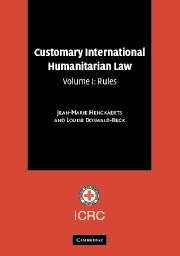Book contents
- Frontmatter
- Contents
- Foreword by ICRC President Jakob Kellenberger
- Foreword by Judge Abdul G. Koroma
- Foreword by Yves Sandoz
- Acknowledgements
- Introduction
- List of abbreviations
- Part I The Principle of Distinction
- Part II Specifically Protected Persons and Objects
- Part III Specific Methods of Warfare
- Part IV Weapons
- Chapter 20 General Principles on the Use of Weapons (Rules 70–71)
- Chapter 21 Poison (Rule 72)
- Chapter 22 Nuclear Weapons
- Chapter 23 Biological Weapons (Rule 73)
- Chapter 24 Chemical Weapons (Rules 74–76)
- Chapter 25 Expanding Bullets (Rule 77)
- Chapter 26 Exploding Bullets (Rule 78)
- Chapter 27 Weapons Primarily Injuring by Non-detectable Fragments (Rule 79)
- Chapter 28 Booby-traps (Rule 80)
- Chapter 29 Landmines (Rules 81–83)
- Chapter 30 Incendiary Weapons (Rules 84–85)
- Chapter 31 Blinding Laser Weapons (Rule 86)
- Part V Treatment of Civilians and Persons Hors De Combat
- Part VI Implementation
Chapter 30 - Incendiary Weapons (Rules 84–85)
Published online by Cambridge University Press: 05 June 2012
- Frontmatter
- Contents
- Foreword by ICRC President Jakob Kellenberger
- Foreword by Judge Abdul G. Koroma
- Foreword by Yves Sandoz
- Acknowledgements
- Introduction
- List of abbreviations
- Part I The Principle of Distinction
- Part II Specifically Protected Persons and Objects
- Part III Specific Methods of Warfare
- Part IV Weapons
- Chapter 20 General Principles on the Use of Weapons (Rules 70–71)
- Chapter 21 Poison (Rule 72)
- Chapter 22 Nuclear Weapons
- Chapter 23 Biological Weapons (Rule 73)
- Chapter 24 Chemical Weapons (Rules 74–76)
- Chapter 25 Expanding Bullets (Rule 77)
- Chapter 26 Exploding Bullets (Rule 78)
- Chapter 27 Weapons Primarily Injuring by Non-detectable Fragments (Rule 79)
- Chapter 28 Booby-traps (Rule 80)
- Chapter 29 Landmines (Rules 81–83)
- Chapter 30 Incendiary Weapons (Rules 84–85)
- Chapter 31 Blinding Laser Weapons (Rule 86)
- Part V Treatment of Civilians and Persons Hors De Combat
- Part VI Implementation
Summary
Rule 84. If incendiary weapons are used, particular care must be taken to avoid, and in any event to minimise, incidental loss of civilian life, injury to civilians and damage to civilian objects.
Practice
Volume II, Chapter 30, Section A.
Summary
State practice establishes this rule as a norm of customary international law applicable in both international and non-international armed conflicts.
International armed conflicts
The discussions in the 1970s at the UN General Assembly and during the diplomatic conferences that led to the adoption of the Additional Protocols and the Convention on Certain Conventional Weapons show that the use of incendiary weapons is a sensitive issue. The controversy was occasioned in particular by the effects of these weapons during the Vietnam War, and a large number of States advocated a total prohibition of their use. The majority of those that did not subscribe to a total ban did urge strict restrictions in order to avoid civilian casualties.
The treaty provisions finally adopted by consensus in Protocol III to the Convention on Certain Conventional Weapons reflect the latter trend, not only by repeating the principle of distinction applicable to the use of all weapons, but also by prohibiting the use of air-delivered incendiary weapons against military objectives located within a concentration of civilians and by restricting the use of other incendiary weapons within such a concentration. Fewer than half of all States are party to this treaty.
- Type
- Chapter
- Information
- Customary International Humanitarian Law , pp. 287 - 291Publisher: Cambridge University PressPrint publication year: 2005

